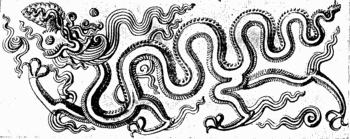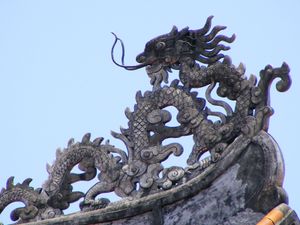Vietnamese dragon
In Vietnam, the dragon (Vietnamese: rồng or long) is one the most important and sacred symbols. Similar to other Oriental dragons, it was strongly influenced by the Chinese dragon.
Description
Prehistory
The Vietnamese dragon is the combined image of crocodile, snake, lizard and bird. Historically, Vietnamese people lived near rivers, so they venerated crocodiles as "Giao Long", the first kind of Vietnamese dragon.
There are some kinds of dragons found on archaeological objects: crocodile-dragons (dragons with crocodile head and snake body). The cat-dragon excavated on a glazed terracotta piece in Bac Ninh has some features of Dai Viet period dragon: it does not have a crocodile head, its head is shorter and it has a long neck, its wing and backfin are long lines, and its whiskers and fur are found in the Dai Viet dragon image.
Ngo dynasty (938–965
On the brick from this period found in Co Loa, the dragon is short, with a cat-like body and a fish's backfin.
Ly dynasty (1010–1225)
The Ly dynasty is the dynasty which laid the foundation of Vietnamese feudal culture. Buddhism was widespread and Van Mieu, the first feudal university, was opened. The slender, flowing dragon of this period represents the King, and is literature dragon.

These dragons' perfectly rounded bodies curve lithely, in a long sinuous shape, tapering gradually to the tail. The body has 12 sections, symbolising 12 months in the year. On the dragon's back are small, uninterrupted, regular fins. The head, held high, is in proportion with the body, and has a long mane, beard, prominent eyes, crest on nose (pointing forwards), but no horns. The legs are small and thin, and usually 3-toed. The jaw is opened wide, with a long, thin tongue; the dragons always keep a châu (gem/jewel) in their mouths (a symbol of humanity, nobility and knowledge). These dragons are able to change the weather, and are responsible for crops.
Tran dynasty (1225–1400)
The Tran dynasty dragon was similar to that of the Ly dynasty but looked more intrepid. The Tran dragon has new details: arms and horns. Its fiery crest is shorter. Its slightly curved body is fat and smaller toward the tail. There are many kinds of tail (straight and pointed tail, spiral tail) as well as many kinds of scale (a regular half-flower scale, slightly curved scale).
The Tran dragon symbolized the martial arts, because the Tran kings were descended from a Mandarin commander. The Vietnamese had to fight Mongol invaders in this age.
Le dynasty
In this period, the Vietnamese dragon's image was influenced by the Chinese dragon, because of Confucianism's expansion policy. Differing from those of the previous dynasty, dragons in this age are not only represented in a curved posture among clouds but also in others. These dragons were majestic, with lion-heads. Instead of a fiery crest, they have a large nose. Their bodies only curve in two sections. Their feet have five sharp claws.
Nguyễn dynasty
(1802–1883) During the early part of Nguyen dynasty, the dragon is represented with a spiral tail and long fiery sword-fin. Dragon was personified, for example, by a mother with her children, the couple of dragons. Its head and eyes are large. It has stag horns, a lion's nose, exposed canine teeth, regular flash scale, curved whiskers. Dragon images made for the King have 5 claws, others have 4 claws.
Modern era
(1883–1945) In this later period the dragon image degenerated and became unrefined, losing its natural and majestic shape, and was seen as a signal of the decline in art of the last Vietnamese dynasty.
Dragon in literature
Some proverbs and sayings mention dragons but imply something else:
- "Rồng gặp mây": "Dragon meets clouds" – In favourable condition.
- "Đầu rồng đuôi tôm": "Dragon's head, shrimp's tail" – Good at first and bad at last; something which starts well but ends badly.
- "Rồng bay, phượng múa": "Dragon flight, phoenix dance" – Used to praise the calligraphy of someone who writes Chinese ideograms well.
- "Rồng đến nhà tôm": "Dragon visits shrimp's house" – A saying used by a host to (or of) his guest: the host portrays himself as a humble shrimp and his guest as a noble dragon.
- "Ăn như rồng cuốn, nói như rồng leo, làm như mèo mửa": "Eating as dragon scrolls, talking as dragon climbs, working as cat vomits" – A criticism of someone who eats too much and talks a lot, but is lazy.
Vietnamese place-names, and other things, named after dragons
Ha Noi (Vietnamese: Hà Nội), the capital of Vietnam, was anciently known as Thăng Long (from Thăng, meaning "to grow, to develop, to rise, to fly, or to ascend" and Long, meaning "dragon"), a name which is still used to refer to the capital for literary effect. In 1010, King Lý Thái Tổ moved the capital from Hoa Lư to Đại La for the reason written down in Chiếu dời đô (Royal proclamation of moving capital). He saw a Rồng vàng (yellow dragon) fly around on the clear blue sky, so he changed the name of Đại La to Thăng Long, meaning "Vietnam's bright and developed future".
Many place-names in Vietnam incorporate the word Long, or Rồng (also meaning dragon): Ha Long Bay (vịnh Hạ Long), the section of the Mekong river flowing through Vietnam contains 9 branches and is called Cửu Long (meaning nine dragons); Hàm Rồng bridge, Long Biên bridge. Other things named after dragons include: Thanh Long (dragonfruit), vòi rồng (waterspout), xương rồng (Cactaceae), long nhãn (dragon eyes: Vietnamese cognate word for longan fruit).
Sources
| From Wikipedia, the free encyclopedia |


